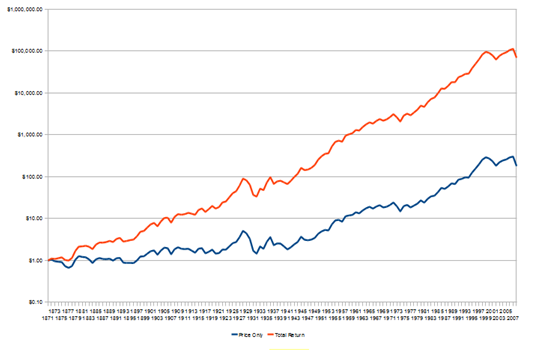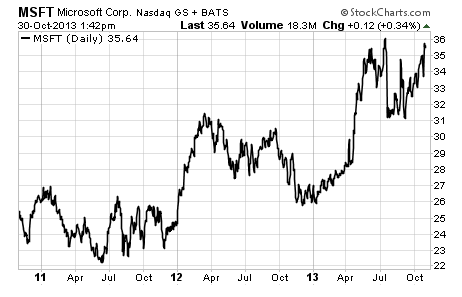The “dividend grower” trade is still one of the most reliable investments going.
And according to a study by Credit Suisse, successfully investing in “dividend growers” is not a recent trend. Credit Suisse broke down the S&P 500 into four equally weighted portfolios which include the following:
- Stocks that grow dividends
- Stocks that pay dividends but do not grow their dividends
- Stocks that pay no dividends
- Stocks that cut their dividends
 As you can clearly see in Credit Suisse’s chart above, stocks that grow their dividends outperform all other categories over the long term.
As you can clearly see in Credit Suisse’s chart above, stocks that grow their dividends outperform all other categories over the long term.
And if the forty-plus years of evidence are not enough to prove that “dividend growers” trump almost all other investments over the long term, take a look at the next chart.
 First, I want to apologize for the small font. But when you are covering 138 years’ (1871 -2009) worth of data, it’s hard to get away from a reduction. However, don’t let this discourage you from the powerful message this chart displays.
First, I want to apologize for the small font. But when you are covering 138 years’ (1871 -2009) worth of data, it’s hard to get away from a reduction. However, don’t let this discourage you from the powerful message this chart displays.
What happens when you invest $1, factoring with or without dividends.
- The $1 would have been worth $181 in 2009 without dividends.
- The $1 would have been worth $70,000 in 2009 with growing dividends.
Unfortunately, none of us will be around that long to reap the rewards of 138 years worth of investing, but you get the point: investing in dividend growers pays handsomely over the long term.
[ad#Google Adsense 336×280-IA]Over the past six months, we’ve highlighted how more and more people are recognizing the power of dividend growers.
With interest rates low, the fashionable thing on Wall Street has been for fund managers to say, “I own safe blue-chip dividend growers.”
Making this idea even more attractive is how well blue-chip dividend growers held up during every market sell-off.
For example, look at the last real sell-off in late 2011.
Riskier stocks fell 25%-50% in just a few months.
But most of our favorite dividend growers held up just fine.
That’s why since that period, investors have been piling into elite dividend growers like Wal-Mart (NYSE: WMT), Microsoft (Nasdaq: MSFT) and Intel (Nasdaq: INTC), caused a surge of buying momentum and have sent their share prices skyrocketing.
Take Microsoft, for example…
Last month, the world’s largest software producer increased its quarterly dividend 22%. Consider that in mid-2010 Microsoft paid just 13 cents a share, so the tech giant has doubled its dividends in about three years.
Like it or not, Microsoft is one of the greatest brand names in the world. The shareholder-friendly, blue-chip tech behemoth provides products necessary for businesses and individuals alike. This makes it one of the most reliable dividend stocks in the world. As you can see from the chart below, it’s drawing huge money flows because of it.
Shares have climbed over 50% since the lows back in late 2011…and is nearing a 52-week high.
 Microsoft’s move is no doubt impressive when you consider that several other big tech names haven’t come close to those types of gains.
Microsoft’s move is no doubt impressive when you consider that several other big tech names haven’t come close to those types of gains.
Readers of High Yield Trader know we recommend “investing” in these types of shareholder-friendly dividend-growers by selling put options or selling covered call options. These strategies are a great way to generate double-digit income streams in a conservative portfolio.
As our returns have shown since we started the High Yield Trader service, this idea is working and working well beyond our expectations.
— Andy Crowder
[ad#wyatt-generic]
Source: Wyatt Investment Research

